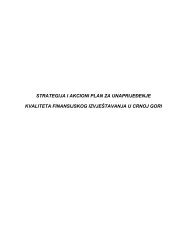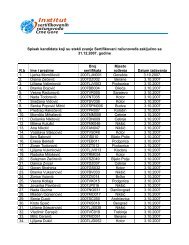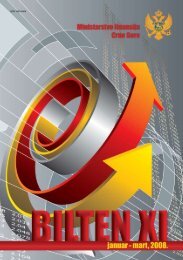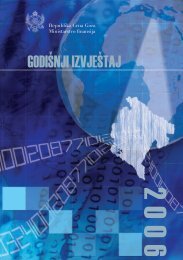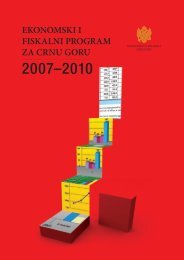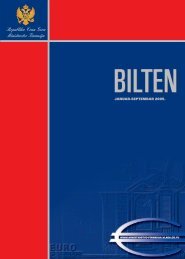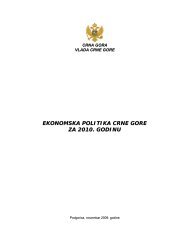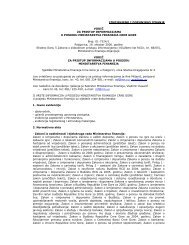director - Ministarstvo finansija
director - Ministarstvo finansija
director - Ministarstvo finansija
You also want an ePaper? Increase the reach of your titles
YUMPU automatically turns print PDFs into web optimized ePapers that Google loves.
Guidebook to the tax system<br />
BULLETIN OF THE MINISTRY OF FINANCE/JANUARY-MARCH 2006<br />
KOVILJKA MIHAILOVIĆ, ASSISTANT TO THE MINISTER OF FINANCE<br />
Guidebook to the<br />
tax system of<br />
Montenegro<br />
Introductory Remarks<br />
Montenegro launched reforms of the tax system and overall financial system in 2001.<br />
Main objectives of the tax reform are primarily focused on: encouraging domestic production<br />
and investments; making Montenegro more attractive to foreign investors; making locally<br />
produced goods more competitive at foreign markets; harmonization of the tax system with the EU Directives and international<br />
standards; making the tax system simpler, more efficient and easier for implementation; and generating income required for<br />
budget needs support. The tax reform is based on the principles of simplicity, fairness, impartiality, efficiency, stability and applicability.<br />
Key segments of the tax reform are: introduction of the value added tax (which has been applied since 1 April 2003), which replaced<br />
previous retail tax; and use of the self-assessment principle according to which a tax liability is calculated by a taxpayer himself,<br />
while the related procedure is controlled by a tax authority. In addition, the tax administration has also been transformed, and<br />
some competences related to collection of local revenues have accordingly been delegated to the local self-government.<br />
STRUCTURE OF THE TAX SYSTEM<br />
Montenegrin Tax System includes the following taxes:<br />
1. Customs and other Duties,<br />
2. Excises,<br />
3. Value Added Tax,<br />
4. Corporate Income Tax,<br />
5. Personal Income Tax,<br />
6. Property Tax,<br />
7. Real Estate Transfer Tax,<br />
8. Insurance Premium Tax,<br />
9. Tax on Use of Passenger Motor Vehicles, Vessels and Aircraft<br />
10. Contributions for Compulsory Social Insurance (pension,<br />
disability, health and unemployment insurance),<br />
11. Sales Tax on Used Motor Vehicles, Vessels and Aircraft,<br />
12. Republic Stamp Duties (administrative fees and duties, court<br />
fees, registration fees),<br />
13. Charges for Use of Natural Resources of Common Interest<br />
(forests, waters, mineral resources, roads, coastal zone, organization<br />
of games of chance), and<br />
14. Local Revenues (taxes, charges and fees).<br />
The Table below shows a comparative review of structure of<br />
realized revenues by individual tax types and levels (Republic<br />
and Local level) for 2003 and 2004.<br />
10



